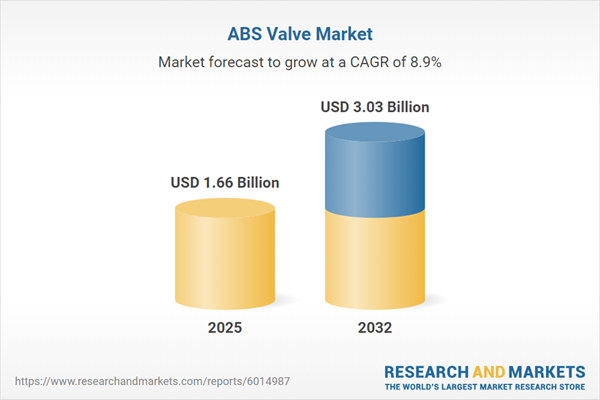Speak directly to the analyst to clarify any post sales queries you may have.
The ABS valve market is evolving rapidly as organizations prioritize modernization, operational stability, and compliance with increasingly complex regulatory frameworks. Senior decision-makers in industrial sectors are seeking advanced solutions that optimize resource management and ensure process integrity.
Market Snapshot: ABS Valve Market Growth and Outlook
The ABS valve market is projected to advance from USD 1.53 billion in 2024 to USD 1.66 billion in 2025 and is expected to reach USD 3.03 billion by 2032. This robust growth, reflected in an 8.89% compound annual growth rate (CAGR), highlights the sector’s momentum. Factors driving expansion include engineering innovations, growing regulatory and compliance pressures, and ongoing adoption of real-time monitoring solutions. Key industries such as manufacturing, utilities, and energy are integrating ABS valves to enhance operational transparency and maintain reliable system uptime. Organizations globally are embracing these technologies as part of their broader modernization and compliance strategies.
ABS Valve Market Scope & Segmentation
- Valve Types: Ball valves support rapid system isolation; butterfly valves are valued for low pressure drop; check valves prevent reverse flow; gate valves maintain consistent full-flow, and globe valves offer precise flow control for specialized process needs.
- End-User Industries: Automotive, oil and gas, chemical processing, power generation, and water treatment sectors depend on ABS valves for equipment reliability and strict adherence to industry standards in increasingly regulated environments.
- Material Types: Resilient metals such as Hastelloy, Inconel, carbon steel, bronze alloys, cast iron, and stainless steel (304/316 grades) deliver corrosion resistance and sustain performance under significant thermal and pressure stresses.
- Applications: Used to control flow, isolate segments of industrial systems, provide over-pressure relief for safety, and manage temperature—each application is central to process efficiency and compliance management.
- Pressure Ratings: Designed for high, medium, and low-pressure operations, enabling flexible integration into both modern and legacy fluid management infrastructures and supporting safety across a variety of critical contexts.
- Regions: The market spans the Americas, Europe, the Middle East and Africa, and Asia-Pacific. Each region presents its own set of regulatory approaches, technology adoption patterns, and infrastructure standards, influencing ABS valve integration strategies and growth rates.
- Companies Profiled: Prominent organizations including Robert Bosch GmbH, Continental AG, ZF Friedrichshafen AG, DENSO Corporation, Aisin Seiki Co., Ltd., Aptiv PLC, WABCO Holdings, Inc., Hitachi Astemo, Ltd., Brembo S.p.A., and Knorr-Bremse AG supply deep expertise and a broad portfolio, ensuring comprehensive sector coverage.
Key Takeaways: Trends in the ABS Valve Market
- The rise of digital technologies—including integrated sensors and connected systems—supports proactive maintenance, improves monitoring capabilities, and strengthens operational resilience by minimizing unexpected failures.
- Material selection is increasingly strategic; durable alloys are favored for their ability to withstand harsh operating conditions and critical plant reliability over extended service periods.
- Additive manufacturing is accelerating prototyping and customization, providing engineers with greater agility to meet complex system needs and reduce lead time for deployment.
- Plant management system integration is expanding the availability of operational data, supplying analytics that empower technical teams with actionable insights and enhancing decision-making across departments.
- Ongoing design and material optimization—especially in compliance-driven settings—enables organizations to manage long-term asset costs while ensuring consistent process reliability.
Tariff Impact
Recent adjustments in US tariff regulations are compelling ABS valve manufacturers to diversify supply chains. This shift aims to sustain product availability and protect production continuity amid unpredictable global trade realignments.
ABS Valve Market Research Methodology & Data Sources
This analysis draws on validated industry databases, audited trade statistics, and insights from senior technical and industry professionals. A thorough peer review process confirms the impartiality and accuracy of all findings.
Why This Report Matters
- Supports executive and capital planning with precise market intelligence, enabling effective risk assessment and ongoing operational dependability.
- Equips procurement and operations leaders to respond to regulatory and supply chain fluctuations, bolstering sourcing flexibility and process adaptation.
- Provides actionable intelligence on sourcing, automation, and compliance, fostering coordinated progress among technical, operational, and strategic teams.
Conclusion
This ABS valve market analysis enables senior leaders to anticipate industry shifts, strengthen operational resilience, and guide informed technology adoption in today’s fluid regulatory and operational landscape.
Additional Product Information:
- Purchase of this report includes 1 year online access with quarterly updates.
- This report can be updated on request. Please contact our Customer Experience team using the Ask a Question widget on our website.
Table of Contents
3. Executive Summary
4. Market Overview
7. Cumulative Impact of Artificial Intelligence 2025
Companies Mentioned
The companies profiled in this ABS Valve market report include:- Robert Bosch GmbH
- Continental AG
- ZF Friedrichshafen AG
- DENSO Corporation
- Aisin Seiki Co., Ltd.
- Aptiv PLC
- WABCO Holdings, Inc.
- Hitachi Astemo, Ltd.
- Brembo S.p.A.
- Knorr-Bremse AG
Table Information
| Report Attribute | Details |
|---|---|
| No. of Pages | 183 |
| Published | October 2025 |
| Forecast Period | 2025 - 2032 |
| Estimated Market Value ( USD | $ 1.66 Billion |
| Forecasted Market Value ( USD | $ 3.03 Billion |
| Compound Annual Growth Rate | 8.8% |
| Regions Covered | Global |
| No. of Companies Mentioned | 11 |









